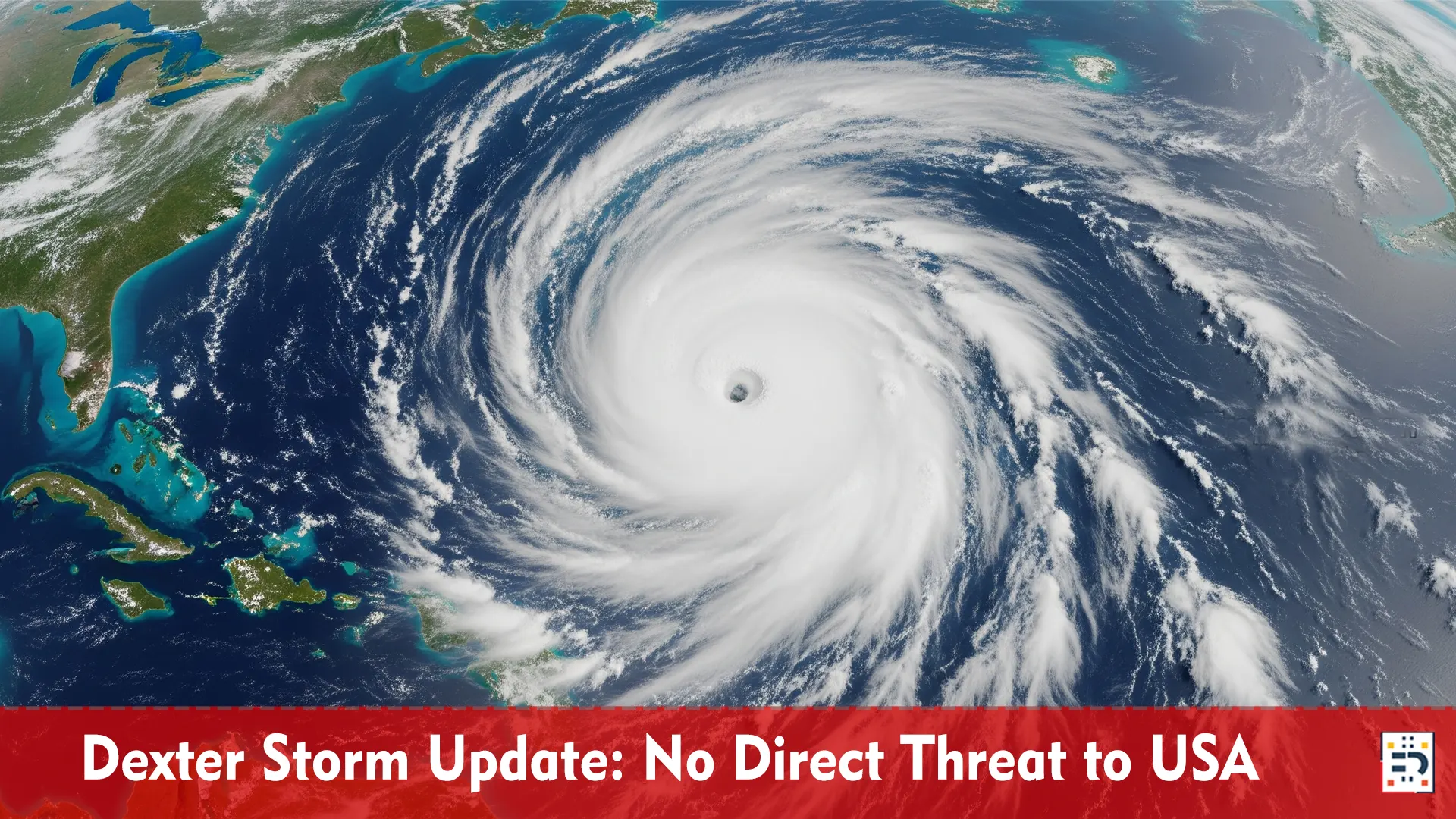Tropical Storm Dexter 2025: Current Status and Path Updates
What is Tropical Storm Dexter?
Tropical Storm Dexter is a cyclonic weather system that developed in the Atlantic Ocean during August 2025, characterized by organized thunderstorm activity and sustained winds between 39-73 mph. Named as the fourth storm of the 2025 Atlantic hurricane season, Dexter represents a typical tropical cyclone formation where warm ocean waters fuel the development of a low-pressure system with rotating winds. Unlike hurricanes, which have winds exceeding 74 mph, tropical storms like Dexter pose significant threats through heavy rainfall, storm surge, and tropical storm-force winds, but generally cause less structural damage. The storm follows the World Meteorological Organization’s predetermined naming convention for Atlantic tropical cyclones, with “Dexter” being the fourth name on the 2025 list after Andrea, Bret, and Cindy.
Breaking: Dexter Moves Away from US East Coast
Tropical Storm Dexter 2025 has officially formed in the Atlantic Ocean, becoming the fourth named storm of the active 2025 Atlantic hurricane season. Tropical Storm Dexter formed off the U.S. East Coast in the Atlantic Ocean on Sunday night, bringing both relief and continued vigilance to coastal communities from Florida to Maine.

Current Dexter Storm Tracking:
- Location: Atlantic Ocean, moving northeast away from US coast
- Wind Speed: Tropical storm force winds extending 140 miles from center
- Pressure: 1002 mb central pressure
- Movement: Expected to continue moving away from the U.S. east coast and remain north of Bermuda
For real-time tracking: National Hurricane Center Official Tracking
Good News: Dexter Hurricane Threat Diminishing for USA
The National Hurricane Center reports encouraging news for American coastal residents. Dexter is moving away from the U.S., and expected to become ripped apart by stronger wind shear. This tropical storm is following the pattern of other 2025 Atlantic storms that have remained short-lived and posed minimal direct threats to the mainland United States.
Stay updated with official forecasts at Weather.gov
Hurricane Safety USA: Essential Preparedness Guide 2025
Why Hurricane Preparedness Matters More Than Ever
Moreover, the 2025 Atlantic hurricane season has been predicted to be above-normal, making comprehensive hurricane safety planning critical for all Americans in vulnerable regions. Furthermore, recent storms like Hurricane Helene in 2024 demonstrated that hurricane damage can extend far beyond coastal areas, consequently affecting communities hundreds of miles inland.
Understanding the Increasing Hurricane Threat
Additionally, hurricane forecasters warn that while individual storms like Tropical Storm Dexter may remain offshore, the overall season activity requires heightened preparation. Specifically, climate patterns suggest:
- Above-normal hurricane activity predicted for 2025
- Increased storm intensity potential due to warm ocean temperatures
- Extended inland impacts from flooding and wind damage
- Rapid intensification possibilities for storms entering the Gulf of Mexico
Peak Season Timing and Risks
Notably, the peak months of August through October present the highest risk period. Therefore, residents should maintain heightened awareness during this critical timeframe.
Complete Hurricane Emergency Kit Checklist USA
Essential Hurricane Supplies Every American Household Needs
First and foremost, building a comprehensive hurricane emergency kit is your first line of defense. Additionally, a minimum of three days worth of non-perishable food, water and medicine per person forms the foundation of effective storm preparedness.
Complete emergency kit guidelines: Ready.gov Hurricane Preparedness
Core Survival Supplies
Primary Hurricane Emergency Supplies:
Water and Food Security
- Water storage: 1 gallon per person per day (minimum 3-day supply)
- Non-perishable food: Canned goods, dried fruits, nuts, protein bars
- Manual can opener and disposable plates/utensils
- Baby formula and pet food if applicable
Power and Communication Essentials
Furthermore, maintaining communication during power outages is crucial for safety:
- Battery-powered weather radio with NOAA alerts
- Flashlights with extra batteries (LED recommended)
- Portable phone chargers and power banks
- Solar-powered charging devices for extended outages
Medical and Safety Items
Similarly, health and safety supplies are equally important:
- First aid kit with bandages, antiseptics, pain relievers
- Prescription medications (7-day supply minimum)
- Personal hygiene items and sanitation supplies
- Important documents in waterproof containers
Financial Preparedness
Finally, financial readiness ensures access to resources when electronic systems fail:
- Cash reserves ($200-500 recommended)
- Credit cards and identification copies
- Insurance documentation easily accessible

USA Regional Hurricane Risks and Preparation
Atlantic Coast Hurricane Zones (Maine to Florida)
Generally speaking, the Atlantic Coast faces unique challenges due to its extensive coastline exposure.
Primary hurricane threats:
- Storm surge flooding in low-lying coastal areas
- High winds causing structural damage and power outages
- Evacuation zone requirements vary by location
- Peak hurricane season: August through October
Coastal Preparation Strategies
Consequently, regional preparation focus should include:
- Know your hurricane evacuation zone – Find Your Zone (FEMA)
- Secure hurricane shutters or plywood for windows
- Understand local storm surge maps – NOAA Storm Surge Maps
- Register for emergency alert systems – Local Emergency Management
Gulf Coast Hurricane Preparedness (Texas to Florida)
In contrast, the Gulf Coast faces the highest risk for major hurricane landfalls due to:
- Warm Gulf waters that fuel rapid storm intensification
- Shallow coastal waters that amplify storm surge heights
- Dense population centers requiring complex evacuation planning
Gulf Coast Specific Preparations
Therefore, Gulf Coast specific preparations should include:
- Hurricane shutters and structural reinforcements
- Elevation planning for storm surge scenarios
- Inland evacuation routes mapped and practiced
- Community shelter locations identified
Understanding Inland Hurricane Impacts
Inland Hurricane Safety Planning
Despite common misconceptions, hurricane impacts extend far inland, as demonstrated by recent storms affecting:
- Mountain communities through flooding and landslides
- Urban areas via wind damage and extended power outages
- Rural regions with limited emergency response resources
Inland Preparation Strategies
As a result, inland preparation strategies should focus on:
- Flood insurance even outside designated flood zones
- Generator safety and carbon monoxide prevention
- Tree maintenance to reduce wind damage risks
- Water well backup plans for power-dependent systems
Hurricane Warning Systems and Weather Alerts
Staying Informed: Official Hurricane Information Sources
Most importantly, staying informed through reliable sources can save lives during hurricane events.
Primary Information Sources
Reliable hurricane tracking sources:
Federal Weather Services
- National Hurricane Center (NHC): Official hurricane forecasts and warnings
- National Weather Service: Local weather alerts and detailed forecasts
- NOAA Weather Radio: 24/7 automated weather information
- Ready.gov: Federal emergency preparedness resources
State and Local Resources
- State emergency management agencies: Region-specific guidance
- County emergency services: Local evacuation and shelter information
- Municipal alert systems: Community-specific updates and instructions
Technology-Based Alerts
Additionally, modern technology provides multiple alert channels:
- Weather apps with push notifications enabled
- Emergency alert system (EAS) broadcasts
- Social media official accounts for real-time updates
- Text alert subscriptions from local authorities
Multi-Channel Communication Strategy
Furthermore, experts recommend establishing multiple communication methods since single systems may fail during severe weather events.

Hurricane Safety During and After Storms
During Hurricane Conditions: Critical Safety Rules
When a hurricane approaches, following established safety protocols becomes essential for survival.
Immediate Safety Protocols
Immediate safety protocols:
- Stay indoors away from windows and exterior walls
- Monitor weather radio for official updates and instructions
- Avoid candles – use battery-powered lighting only
- Never venture outside during the eye of the storm
Power Outage Safety Measures
Additionally, power outage safety requires specific precautions:
- Generator operation only in well-ventilated outdoor areas
- Carbon monoxide detectors with fresh batteries
- Food safety – discard perishables after 4 hours without power
- Water conservation – fill bathtubs before power loss
Post-Hurricane Recovery and Safety
After the storm passes:
- Wait for official all-clear before leaving shelter
- Avoid flood waters that may contain contamination
- Document property damage with photos for insurance
- Check on neighbors especially elderly and disabled residents
Infrastructure safety concerns:
- Downed power lines – assume all are energized
- Structural damage assessment before re-entering buildings
- Water system safety – boil water if advised by authorities
- Road hazards including debris and flooding
Tropical Storm Dexter: Lessons for Future Hurricane Seasons
Current Storm Analysis and Implications
While Tropical Storm Dexter poses minimal direct threat to the United States, it provides valuable insights:
- Storm formation patterns in the 2025 season
- Forecasting accuracy improvements in track prediction
- Coastal preparedness effectiveness for future threats
- Community response coordination opportunities
Climate Trends and Future Hurricane Activity
Long-term hurricane patterns suggest:
- Warmer ocean temperatures supporting stronger storms
- Sea level rise increasing storm surge impacts
- Changing storm tracks potentially affecting new regions
- Rapid intensification becoming more common
Hurricane Insurance and Financial Preparedness
Essential Insurance Coverage for Hurricane Protection
Comprehensive hurricane insurance planning:
Property Protection
- Homeowners insurance with adequate dwelling coverage – Insurance Information Institute
- Flood insurance (separate policy required)
- Personal property coverage including temporary living expenses
- Business interruption insurance for self-employed individuals
Financial Safety Nets
- Emergency fund covering 3-6 months expenses
- Important document storage in secure, accessible locations
- Inventory documentation with photos and receipts
- Contact information for insurance agents and adjusters
Community Hurricane Preparedness and Resources
Building Resilient Communities
Effective community hurricane preparedness involves:
- Neighborhood communication networks for emergency coordination
- Vulnerable population support for elderly and disabled residents
- Local business continuity planning to maintain essential services
- School and workplace emergency protocols clearly established
Volunteer and Support Opportunities
Hurricane response volunteering:
- American Red Cross disaster relief training
- Community Emergency Response Teams (CERT) local programs
- Salvation Army emergency services support
- Local faith-based organizations shelter and aid coordination
Hurricane Season 2025: Staying Prepared Throughout
Monthly Preparedness Actions
June-July: Early Season Preparation
- Review and update emergency plans
- Restock hurricane supply kits
- Schedule property maintenance (tree trimming, roof inspection)
- Confirm insurance coverage adequacy
August-October: Peak Season Vigilance
- Monitor weather forecasts daily
- Maintain emergency kit readiness
- Stay informed about approaching systems
- Practice evacuation procedures if needed
November-December: Season Wrap-up
- Assess preparedness effectiveness
- Replenish used emergency supplies
- Document lessons learned
- Plan improvements for next season
Tropical Storm Dexter and Hurricane Readiness
Tropical Storm Dexter 2025 serves as an important reminder that effective hurricane preparedness requires year-round attention and community-wide commitment. While this particular storm moves harmlessly away from the United States, the lessons it provides about storm formation, tracking, and community response remain valuable for future hurricane seasons.
The 2025 Atlantic hurricane season continues with the potential for more significant threats to American coastal and inland communities. By maintaining comprehensive hurricane emergency kits, staying informed through official weather services, and participating in community preparedness efforts, residents can significantly reduce their vulnerability to future storm impacts.
Key takeaways for hurricane safety:
- Preparation saves lives – don’t wait for storm approaches
- Multiple information sources ensure you receive critical updates
- Community cooperation enhances everyone’s safety and recovery
- Annual plan reviews keep preparedness current and effective
Stay vigilant, stay prepared, and stay connected with your local emergency management resources throughout the remainder of the 2025 hurricane season.


